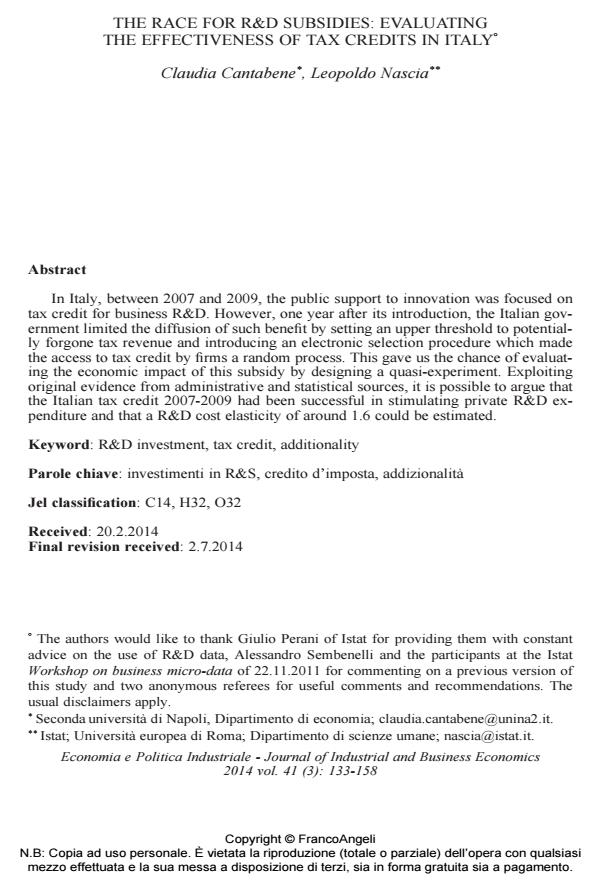The race for R&D subsidies: evaluating the effectiveness of tax credits in Italy
Journal title ECONOMIA E POLITICA INDUSTRIALE
Author/s Claudia Cantabene, Leopoldo Nascia
Publishing Year 2014 Issue 2014/3
Language Italian Pages 26 P. 133-158 File size 122 KB
DOI 10.3280/POLI2014-003006
DOI is like a bar code for intellectual property: to have more infomation
click here
Below, you can see the article first page
If you want to buy this article in PDF format, you can do it, following the instructions to buy download credits

FrancoAngeli is member of Publishers International Linking Association, Inc (PILA), a not-for-profit association which run the CrossRef service enabling links to and from online scholarly content.
In Italy, between 2007 and 2009, the public support to innovation was focused on tax credit for business R&D. However, one year after its introduction, the Italian government limited the diffusion of such benefit by setting an upper threshold to potentially forgone tax revenue and introducing an electronic selection procedure which made the access to tax credit by firms a random process. This gave us the chance of evaluating the economic impact of this subsidy by designing a quasi-experiment. Exploiting original evidence from administrative and statistical sources, it is possible to argue that the Italian tax credit 2007-2009 had been successful in stimulating private R&D expenditure and that a R&D cost elasticity of around 1.6 could be estimated.
Keywords: R&D investment, tax credit, additionality
Jel codes: C14, H32, O32
- The intensity of business R&D in Italy: why reducing the gap with the EU is possible and worthwhile Alessandro Sterlacchini, in Economia e Politica Industriale /2017 pp.245
DOI: 10.1007/s40812-016-0068-z - R&D tax incentives in EU countries: does the impact vary with firm size? Alessandro Sterlacchini, Francesco Venturini, in Small Business Economics /2019 pp.687
DOI: 10.1007/s11187-018-0074-9 - How Does the Evolution of R&D Tax Incentives Schemes Impact Their Effectiveness? Evidence From a Meta-Analysis Florence Blandinières, Daniela Steinbrenner, in SSRN Electronic Journal /2021
DOI: 10.2139/ssrn.3805605 - Effectiveness of R&D subsidies during the crisis: firm-level evidence across EU countries David Aristei, Alessandro Sterlacchini, Francesco Venturini, in Economics of Innovation and New Technology /2017 pp.554
DOI: 10.1080/10438599.2016.1249543 - Liquidity and Firms’ Response to Fiscal Stimulus Antonio Acconcia, Claudia Cantabene, in The Economic Journal /2018 pp.1759
DOI: 10.1111/ecoj.12499 - The interconnection between fiscal policy and foreign direct investment with R&D: Insights from East Asian countries Sadik Aden Dirir, in Upravlenets /2023 pp.15
DOI: 10.29141/2218-5003-2023-14-4-2
Claudia Cantabene, Leopoldo Nascia, The race for R&D subsidies: evaluating the effectiveness of tax credits in Italy in "ECONOMIA E POLITICA INDUSTRIALE " 3/2014, pp 133-158, DOI: 10.3280/POLI2014-003006